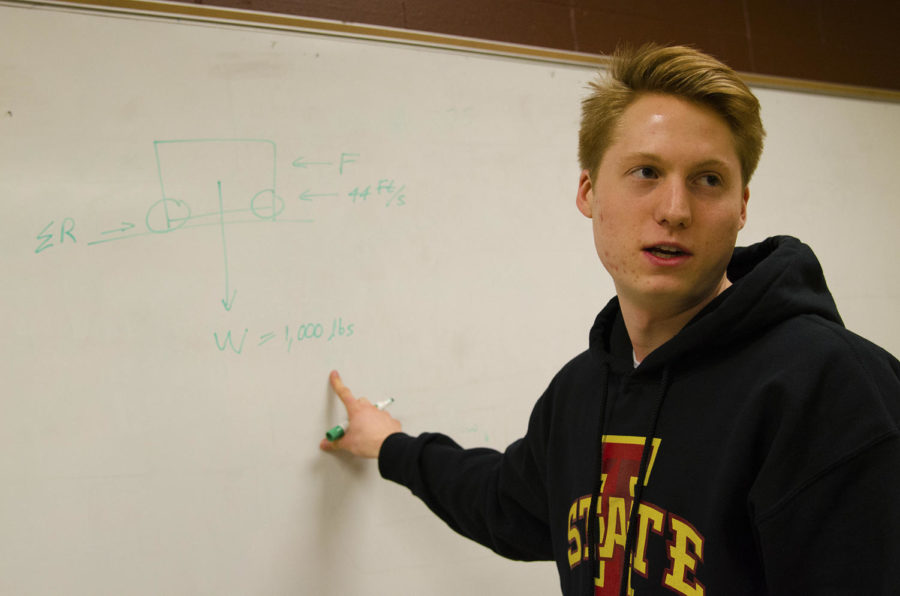Renewable Energy Vehicle Club has optimistic goals
March 5, 2013
In the spring of 2012, Tyler Cain had an idea. A year later, his idea has grown into his passion project: the REV club.
REV stands for Renewable Energy Vehicle. Think along the lines of hybrid cars, except the Renewable Energy Vehicle would not run on fossil fuels at all.
Cain and other members are hoping to tap into a combination of water and solar energy.
Cain explained that the water will sit in a divided tank with an electrode on each end; using energy gathered by the sun, an electric current will be sent through the water.
“Hydrogen will then separate from the water. After the separation, it will be collected, compressed and stored in a tank. This way the maximum amount of fuel can be stored,” Cain said.
As a bonus, when hydrogen is burnt it combines with oxygen to create more water. The byproduct can then be recaptured and fed back into the water supply to help perpetuate itself.
“There are safety issues that need to be addressed,” Cain said.
Cain explained that hydrogen is very flammable, so if something goes wrong in the burning process, fail-safe features need to be put into place.
One option is having a roof that can be punched out to allow for a swift escape. What the members of the Renewable Energy Vehicle Club will use as a safety option is uncertain at this point.
There are currently eight official members; they have all been there since the beginning of the club. Ever since Cain sent out a mass email detailing the club’s goal, he has received 65 responses from prospective members.
“I was so excited when I got the emails,” Cain said.
Cain said that members do not have to have an experienced background to join. However, he admits that it would be helpful to have some knowledge of engineering. Members are only required to put in one hour per week.
“It’s a very hands-on club; the students make all the decisions,” Cain said.
The Renewable Energy Vehicle Club is designing renewable energy vehicles for the experience, but also to compete in P3, or Peak Performance Project. P3 is an event put on by the Environmental Protection Agency.
“[P3] was developed nine years ago by someone who is no longer with the [Environmental Protection Agency] as a student design competition to try and introduce sustainability into engineering design,” said Cynthia Nolt-Helms, of the Washington branch of EPA’s Office of Research and Development.
P3 begins with intense amounts of research and ends with demonstration of an actual model during the National Sustainability Design Exposition.
The designs are evaluated by a panel of experts selected from the American Association for the Advancement of Science. The EPA provides these judges with criteria in each category with which to evaluate.
The best student designs have the opportunity to take home grants up to $90,000.
“We have had some for-profit businesses arise out of this competition,” Nolt-Helms said.
The National Sustainable Design Exposition is held annually on the National Mall in Washington, D.C. It is open to the public and showcases not only the P3 competition, but many other designs and ideas that advance sustainability.
“If I had to choose one word [to describe the Renewable Energy Vehicle Club], it would be ‘exciting,’” Nolt-Helms said. “If I were allowed a few other words, I would also use ‘optimism,’ ‘enthusiasm’ and ‘brighter future.’”
The ISU Renewable Energy Vehicle Club has not made it to Washington yet, but Cain is optimistic that a visit to the expo is not too far off in the future.
“Our goal is to have a rough computer animated model done by the end of the semester. Next semester is when we intend to start fabrication,” Cain said.
When pressed about future plans and decisions, Cain admitted that there is much that still needs to be decided.
For instance, just where the vehicle will be built is up for debate. Who will drive the vehicle at the Expo hasn’t even come up yet in meetings. The club is accomplishing its goal one step at a time.
“There’s hope to solve these problems we face,” Cain said. “We can do something about it right now instead of waiting 10 years down the road.”

















